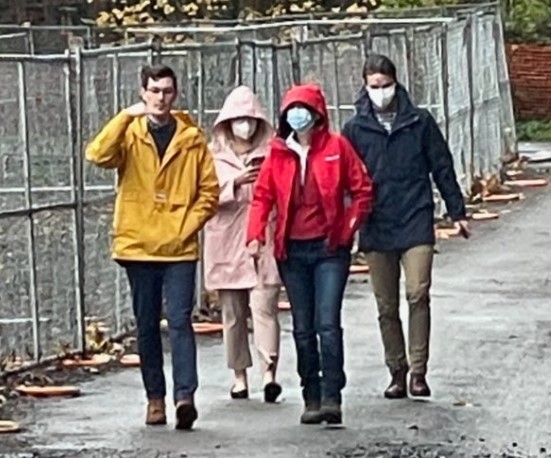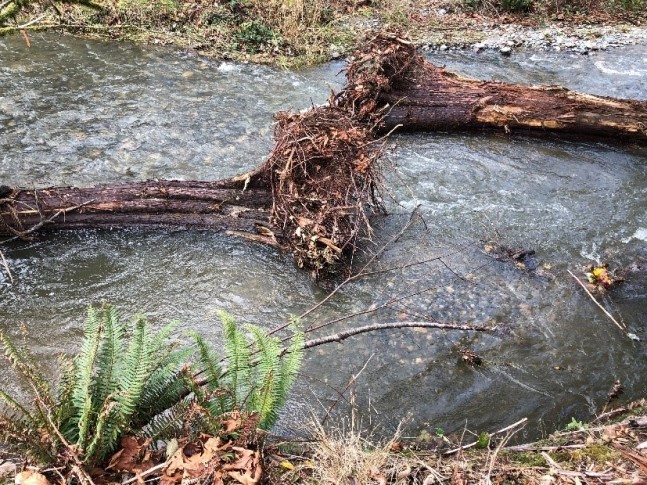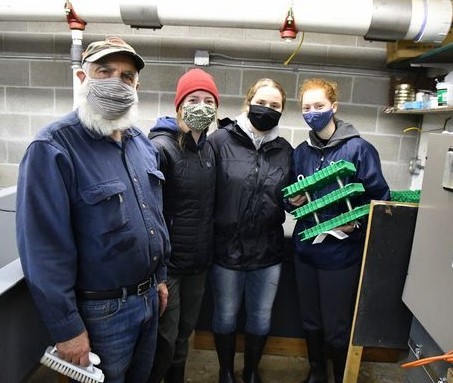|
Puget Sound tribes are restoring vital estuary habitat
 |
| Restoration of the Qwuloolt (a Lushootseed word for “marsh”) estuary near Marysville, WA involved breaching a century old levee in 2015 (left). The same area is shown one year later in 2016 (right). Photos courtesy: Tulalip Tribes |
The importance of restoring river estuaries to protect salmon from predation, flood and storm surges, has become an essential component of salmon recovery. Chinook in particular, spend more time in estuaries to forage, and grow while their bodies adapt to ocean conditions. Tribal governments have been leaders in coordinating with multiple partners to restore estuary habitats around Puget Sound. Restoration efforts on the Skagit, Snohomish (Qwuloolt) and Nisqually River estuaries play a vital role for tribal sovereignty and returning life to the rivers and Puget Sound.
Full article courtesy of UW Puget Sound Institute.
Learning from a legacy of overfishing
In the mid-late 1970s, dwindling salmon populations and increased fishing limits caused state and federal fisheries managers promoted other species, like rockfish, as an alternative to salmon for non-Tribal fishers. There was not a lot of science available at the time to inform decision makers of the impacts of increased fishing on rock fish populations. It takes 20 years to reach mating maturity, and most species of rock fish can live for over 120 years. This limited understanding of the species’ life-cyle resulted in mismanagement of the rockfish population in Puget Sound. By 1999 the state completely banned commercial fishing; however, the species never quite rebounded despite the ban, and in 2010 three species were placed under the Endangered Species Act.
 |
| In 2010, three species of rockfish in Puget Sound were listed under the Endangered Species Act. Shown here from left to right are yelloweye (Sebastes ruberrimus), boccacio (Sebastes paucispinis), and canary (Sebastes pinniger) rockfish. Photos: NOAA Fisheries |
Much has been learned since then, and in 2021 researchers produced a study on young rock fish to inform the rockfish recovery plan. Researchers have also focused on public education and outreach to increase awareness and understanding of rock fish and recovery efforts.
Full article courtesy of Salish Sea Currents.
Nurdles: the worst toxic waste never mentioned
Just three months after the X-Press Pearl was launched into service, the Super Eco-class container ship caught fire and sank, spilling more than 350 tons of heavy fuel oil into the Indian Ocean. What did not make headlines, were the other environmentally harmful chemicals onboard. The ship contained nitric acid, caustic soda and methanol but the most harmful impact came from 87 containers filled with lentil-sized plastic pellets commonly known as nurdles. The toxic beads contain polyethylene, polypropylene, polystyrene, polyvinyl chloride and are often mistaken for food by seabirds, fish and the marine life that feed on those fish and birds.
It is estimated that 230,000 tons of nurdles end up in oceans every year, comprising the second largest micropollutant in the ocean following tire dust. Environmentalists are seeking action from the International Maritime Organization (IMO) to declare nurdles as hazardous and a threat to the environment. Currently, they are not deemed hazardous under the IMO.
Full article courtesy of The Guardian.
Fixing septic systems is key to protecting Puget Sound shellfish
Experts are exploring ways to address human sewage and animal waste which impact the health of Puget Sound shellfish. Shellfish harvesting is a $107 million industry that sustain Indigenous communities. Without measures to improve septic system maintenance and treat waste effectively, clams, geoduck, mussel and oysters, which are filter feeders, consume waste-borne viruses and other damaging pollutants putting those who consume them at adverse risk.
Full article courtesy of Crosscut.
SALMON IN THE NEWS:
Governor Inslee announces $187 million in proposed policies and investments to support salmon recovery
Governor Jay Inslee announced a list of budget and policy changes that would help restore salmon populations in Washington state beginning in 2022. Outline in his updated Salmon Strategy, he addressed the urgency necessary to protect and restore salmon habitat, clean water and build climate resiliency. He detailed this commitment through a biennial work plan and monitoring guidance. He was joined by representatives from the Swinomish, Tulalip and Nisqually tribal communities at the Swinomish Indian Tribal Community reservation.
To read the press release.
Senator Maria Cantwell visits Meadowdale estuary restoration site
 |
| U.S. Senator Maria Cantwell, in red, on project tour |
Snohomish County’s Meadowdale Beach Park has been temporarily reopened to visitors, and U.S. Senator Maria Cantwell visited the site in mid-November to tour the 1.3-acre estuary restoration project. In 2022, additional project work will occur including: Constructing temporary embankments for railroad crossing and railroad bridge construction; removal of 100-feet of embankment and 6-foot wide culvert; beach grading; installation of utilities; finalizing estuary grading and removal of debris and fill material, and planting the site. This project is a high priority for salmon recovery and received state and federal habitat restoration grant funding directed by the WRIA 8 Salmon Recovery Council. .
Full article, and photo courtesy of My Edmonds News.
Holder Creek Restoration Update
 |
| Large wood placed in Holder Creek to restore salmon spawning and rearing habitat |
In August 2021, 42 pieces of in-stream wood were placed along a 1700-foot-long reach of Holder Creek, one of the primary headwater tributary streams to Issaquah Creek, to create pool and slack water habitats to support Chinook spawning and rearing. In October, wild adult Chinook and coho were passed above the Issaquah diversion dam and were found spawning in the vicinity of these in-stream wood structures. Beaver have also been observed within the project area for the first time. Work on this project started in 2018, when King County Water and Land Resources removed livestock fencing and stream crossings, and planted over 40,000 trees, shrubs and willows.
Coho salmon return to Bellevue's Coal Creek
City of Bellevue celebrated the release of adult coho salmon into Coal Creek stream. In partnership with the Muckleshoot Tribe’s Fisheries Department and the Washington Department of Fish and Wildlife (WDFW), nearly 600 coho were transplanted from the Issaquah hatchery and have begun making their way upstream to spawn. This year’s release marks the fourth for Coal Creek.
Over the past couple of decades, the City has done extensive restoration on Coal Creek and other Bellevue stream habitats to support salmon. To learn more about Bellevue’s commitment to improving its local waterways, see the City’s 20-year Watershed Management Plan.
Courageous coho - Larry Franks
WRIA 8 received a count of over 30,000 coho passing through the Chittenden Locks facility this Fall, many of them headed to their home waters of Issaquah Creek. In the past, when the Issaquah Salmon Hatchery coho egg quota has been achieved, they were allowed to pass 3,000 coho upstream to spawn naturally. This year’s record-setting return, and above average precipitation, allowed the fish above the hatchery weir directly.
The accompanying video is of some of these coho that have entered Kees Creek, a tributary of Issaquah Creek about a river mile above the hatchery. Historically, about 7% of fish returning to the Issaquah Hatchery are of natural origin (NOR – retaining an adipose fin).
Edmonds students support local salmon runs
 |
| Joe Scordino and students Sarah Reitz, Megan Labelle and Ann Iliff hold up an assembled group of three hatchboxes |
The Edmonds Stream Team, comprised of 87 area high school students, along with other community volunteers helped fill incubation boxes with over 5,000 coho salmon eggs at the Edmonds Willow Creek Fish Hatchery. The incubation boxes will be placed into Shell, Willow, and Shellabarger Creeks to promote salmon runs in those streams. These efforts in Willow Creek will be further supported by future restoration of Edmonds Marsh and daylighting of Willow Creek, currently in the feasibility and planning phase, to recreate a natural connection to Puget Sound thereby improving juvenile salmon rearing and refuge habitat and enabling adult coho salmon to return to spawn in the creek.
Read the full article courtesy of My Edmonds News.
Robust new lesson plans from Sustainability Ambassadors
Sustainability Ambassadors is developing a new series of lesson plans for middle school and high school classrooms that invite teachers to engage their students in water systems thinking.
The lessons are problem-based, place-based curriculum pathways that align with both the WRIA 8 Chinook Salmon Conservation Plan and the King County Clean Water Healthy Habitat Strategic Plan, the latter intentionally integrated with equity outcomes and climate action.
FUNDING OPPORTUNITIES AND ANNOUNCEMENTS:
Washington State Department of Transportation (WSDOT) announced the Fish Passage Delivery Plan is now available online. The plan lists programmed fish passage barrier corrections subject to the US v WA 2013 Federal Court Injunction, as well as the anticipated biennium in which each site will start design work. Please contact Kim Mueller, Fish Passage Delivery Program Manager for more information.
For projects in King and Snohomish County, please contact Ruth Park, the Northwest Region SnoKing Fish Passage Environmental Manager. To find if there is a fish passage barrier near you, please use this online mapping tool.
Two new King County Parks grant programs:
Healthy Communities & Parks Fund seeks proposals for programs, capacity building, land acquisition, and capital projects that increase access to recreation, parks, and open space in underserved communities. Grants are available up to $250,000 and are due Jan 21, 2022. For more information visit King County Parks’ Grants website or contact Grace Chai, 206-263-7230 or gchai@kingcounty.gov
Open Space – River Corridors Grants seek proposals for projects that restore river habitat, reduce risks from flooding, acquire open space, and enhance recreation opportunities. Approximately $8.5 million is available and proposals are due Jan 31, 2022. For more information visit King County Parks’ Grants website or contact Kelly Heintz, 206-477-6478 or kelly.heintz@kingcounty.gov.
Washington State Department of Natural Resources (DNR) Urban & Community Forestry Grants is now accepting proposals to help improve urban forests and create healthier communities. Applications are due March 4, 2022. Total funding available is $550,000. Read the full press release here.
The Pacific Marine and Estuarine Fish Habitat Partnership (PMEP) requests proposals that restore or protect habitats for PMEP focal species within nearshore and estuarine systems (with an emphasis on habitat connectivity) or proposals that increase our understanding of fish habitats in estuarine and nearshore waters.
The deadline for project proposal submissions is 5:00PM Pacific Time, Friday, February 25, 2022. Access the full RFP at PMEP’s website funding page.
|